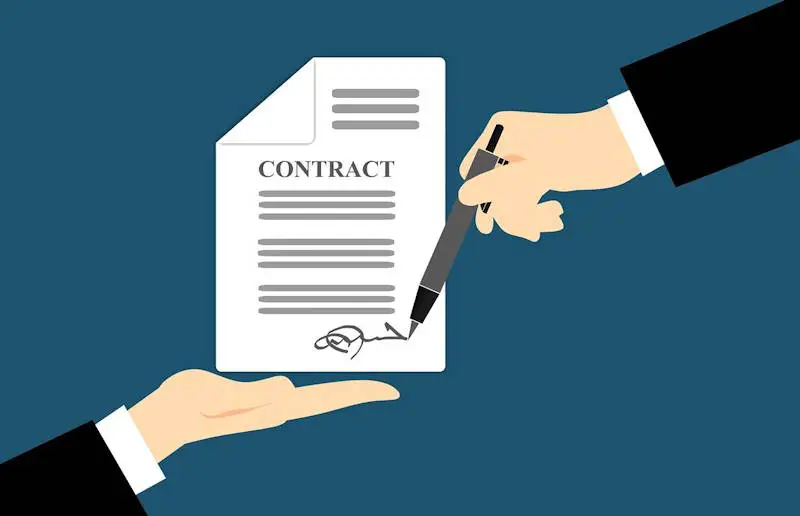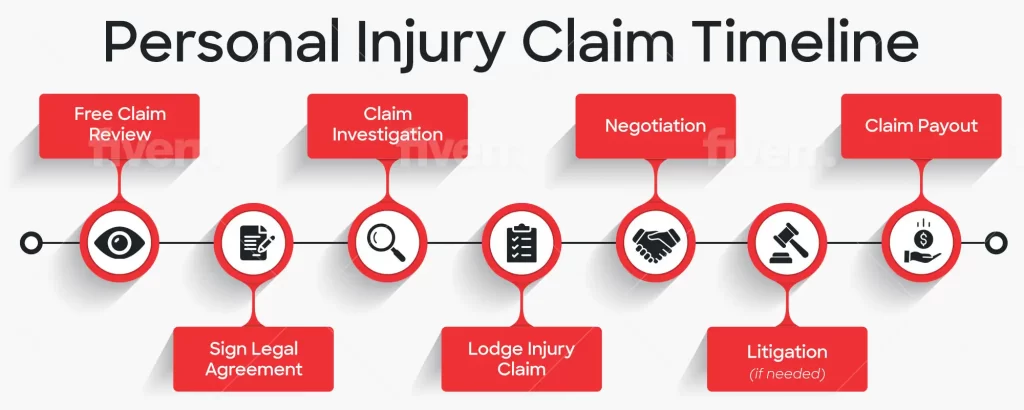- Personal Injury Claims: How Do They Work?
- Definition of a Personal Injury Claim
- Types of Personal Injuries that Qualify for Compensation
- How to Have a Successful Personal Injury Claim
- The Importance of Hiring a Compensation Lawyer
- How Much Compensation for a Personal Injury Claim Payout?
- What is Included in Personal Injury Settlements?
- What is The Time Frame for a Personal Injury Settlement?
- What is the QLD Time Limit for Accident Compensation Claims?
- What is the Personal Injury Claims Process?
- QLD Legislation Relating to Claims for Personal Injury Compensation
- Get Expert Advice from a Personal Injury Lawyer
- Queensland-Wide Personal Injury Lawyers
- FAQs for Personal Injury Compensation Cases
Personal Injury Claims: How Do They Work?
Personal injury claims work by requiring the negligent party to pay legal damages to the injured person, which can be an overwhelming and confusing process. Hence, a compensation lawyer will study law at a university and work in their chosen field for many years to gain expertise in personal injury law.
If you have been injured in an unexpected accident and are considering seeking compensation for physical or psychiatric injury, please review our comprehensive guide to personal injury claims and ask our lawyers for help. Our essential guide will help you understand the following:
- How to make an injury claim
- The workings of a personal injury action and settlements
- Common questions about compensation claims
- and the steps you should take to access your deserved compensation successfully.
What is my claim worth?
Definition of a Personal Injury Claim
A personal injury claim is a legal action for damages in which the injured person seeks compensation for physical or psychological injuries caused by another person or party’s wrongful or negligent actions.
What is Negligence in Personal Injury Cases?
A person is negligent in a personal injury case if they do not exercise the degree of care that a reasonable person would take in a similar situation to ensure the safety of others.
For example, in car accidents, there are many types of negligence actions, including:
- Using a mobile phone while driving
- Disobeying QLD traffic laws
- Dangerous or reckless driving
- Driving under the influence of alcohol or other substances
What Must I Prove to Win a Personal Injury Case?
To have a successful outcome in a personal injury case, you must show the claimant or plaintiff suffered a foreseeable injury due to the defendant’s negligence. There are four elements of a personal injury claim, including:
- Duty: the legal obligation owed to the injured party
- Breach of duty: the defendant owed a duty, and they failed to meet the standard of reasonable care
- Causation: the duty breach caused your injuries
- Damages: The duty failure was to blame for the plaintiff’s loss. When this is shown, they can claim common law damages for lost income and super, medical expenses, cost of home care, and non-economic damages like pain and suffering and emotional distress
Types of Personal Injuries that Qualify for Compensation
Personal injury law covers different types of accidents that result in monetary compensation, the most common ones being:
Car Accident Injuries
There are frequent motor vehicle accident injuries on Queensland roads. You could suffer physical harm accompanied by mental trauma when a swift and violent force impacts you in a:
- Car accident
- Pushbike accident
- Motorcycle crash
- Truck accident
- Public transport accident
- Pedestrian accident
- Hit and run accident
In this circumstance, you could be eligible to make an injury claim. Typical physical damage from motor vehicle accidents includes:
- Whiplash injuries
- Head and neck trauma
- Serious burns
- Bone fractures
- Loss of limb
- Mobility impairment
More about car accident claims >
Work-Related Accidents
You can make a work-related accident claim under numerous circumstances, including:
• Accident on the way to or from work
• During work-related travel or activities.
• Due to employer’s negligence
When approved, WorkCover typically funds your workers’ compensation payments. In Queensland, physical or psychological work injuries are frequently the result of:
- Workplace psychiatric illness
- Work stress and anxiety
- Workplace bullying and harassment
- Occupationally acquired diseases (like lung cancer)
- Falling from a height
- Other slips and trips
- Work-related vehicle accidents
- A moving object strikes you.
More about work injury claims >
Guide to workers’ compensation payouts >
Injuries in Public Places
You can be injured in a public place in diverse and varied situations. Owners and operators of public spaces like shopping centres, council-owned properties, body corporates, car parks, rental properties, (and many others) owe a duty of care to keep you safe. They typically have public liability insurance to protect them financially if something goes wrong. Queensland residents are often harmed in public by:
- Slipping and falling in a public space
- Injury on a council footpath
- Injury on private property (or rental property)
- A sporting or recreational accident
- An animal attack injury
- A faulty product injury
More about public liability claims >
Medical Negligence
You can make a medical negligence claim when doctors, hospitals, surgeons, GPs, and other medical staff fail to provide sufficient medical treatment or care. Negligent medical treatment typically includes misdiagnosis, defective implants, birth injuries, prescription errors, and delayed diagnosis.
Claims for Serious Injuries
Compensation for serious injuries covers a wide range of physical and psychological harms, including those that result in disability or permanent impairment. The Personal Injuries Proceedings Act 2002 (Qld), the Motor Accident Insurance Act 1994, and the Queensland workers’ compensation scheme generally govern these claims. Catastrophic injuries can include conditions such as:
- Fatal accidents
- Brain damage
- Spinal cord injuries
- Severe burns
- Major psychiatric disorders
- Eyesight injuries
- Head and neck injuries
More about serious injury claims >
Free Online Claim Check
How to Have a Successful Personal Injury Claim
A successful personal injury claim relies on evidence. To win, you must:
- Show that the negligence of the other party caused your injury
- Prove your injury caused you a loss (and how much loss)
To do this, you will need evidence to support your claim, including:
- Medical reports and expert assessments
- Photos and video of the accident scene
- Statements from witnesses
- Law enforcement reports or internal work reports
Experienced personal injury lawyers understand the requirements of a compelling case. It’s free to know if you can make a claim. For immediate legal help, Call: 1800 860 777 or email us >

The Importance of Hiring a Compensation Lawyer
Most people only have one compensation claim in their lifetime, and accessing your due compensation can be challenging. Typically, your personal injury lawyer or solicitor will be litigating against a large insurance company on your behalf. Insurers will seek to limit their liability for your harm and find ways to minimise your personal injury settlement.
For this reason, your choice of personal injury compensation law firm is crucial. A knowledgeable injury litigation lawyer will explore all aspects of your case, identify the negligent parties, and support you through the legal process to get you the best possible outcome. They will also negotiate with insurance companies, gather evidence, challenge their decisions, and represent you in court if necessary.

How Much Compensation for a Personal Injury Claim Payout?
Every personal injury compensation claim is different, and hence, its payout value. The nature and severity of physical or psychological damage will vary depending on your unique circumstances, as will their impact on your life. How much compensation you receive in a personal injury settlement depends on:
• The severity of your harm
• Your previous health and your age
• Your current occupation
• How much are you currently paid
• The amount of time you were absent from work.
• How much your injuries have impacted your work capacity.
Your compensation will be worth more if your injuries are significant, you have more time off work, and your current income is high. These factors increase the size of your loss, which is critical in deciding what your injury damages claim is worth. On the other hand, you will receive less if the other party can prove you have contributory negligence.
Learn how personal injury payouts are calculated >
What is my claim worth?

What is Included in Personal Injury Settlements?
The primary goal of compensatory damages in personal injury settlements is to put the injured party back in their position if they had not suffered an injury. When calculating the monetary value of a successful claim payout, several “heads of damages” are considered, making up the total value of personal injury settlements. Factors include:
- The value of lost wages because of time away from work.
- Medical treatment expenses, hospital and rehabilitation costs.
- Your travel-related medical expenses
- Expenses related to your car at home
- Your future loss of income
- Compensation for pain and suffering
Generally, a personal injury settlement is meant to cover the costs incurred from injuries sustained and may be adjusted depending on the specific circumstances. Future losses and compensation for pain and suffering are usually considered for severe injuries.

What is The Time Frame for a Personal Injury Settlement?
Most personal injury cases will typically settle between 3 months and several years. How long it takes to receive compensation depends on a few factors, including:
- Your accident type: motor vehicle injury claims generally settle within six months, while workers’ compensation cases can take up to a year. Other types of more complex claims can take 2 or 3 years.
- Establishing legal liability: means proving who was liable for your harm and linking their action or inaction to your mental or physical condition.
- The severity of your harm: claims for personal injury cannot proceed until injuries are stabilised. Catastrophic damage will take longer to reach this stage.
Splatt Lawyers has been assisting Queenslanders injured by their jobs for close to three decades. It’s free to know where you stand. Our lawyers will give you a time estimate during the claim evaluation process – Call Now 1800 700 125
Get Started Now- It's Free
What is the QLD Time Limit for Accident Compensation Claims?
In Queensland, claims for personal injury damages must begin within three years of the date of your accident (the cause of harm). In some situations, this period of time can be extended. Other conditions apply if the injured party was younger than 18 when the incident occurred.
The success of your compensation claim can depend on your actions soon after your accident, so we recommend you seek informed legal advice as soon as possible. Call Now – 1800 700 125.

What is the Personal Injury Claims Process?
The personal injury claims process is complex and time-consuming, although the steps below may make it seem deceptively simple. The steps for seeking damage compensation in Queensland are as follows:
- Gathering information and evidence
- Create a legal claim strategy.
- File a damages claim
- Assessment of damages
- Negotiating a settlement
- Going to court (if necessary)
- You receive a lump-sum personal injury claim settlement.
Gathering Information and Evidence
The first step in the injury claim process is to gather as much information as possible (claim preparation). An experienced lawyer will help you gather the evidence, like your accident details, medical records, medical specialist assessments, expert testimony, eyewitness statements, police reports, and accident scene photographs.
Filing a Damages Claim
Once all the necessary information and evidence are ready, filing a damages claim is next. This submission involves preparing and submitting a legal document that outlines the details of your case, including the parties involved, the injuries suffered, and the amount of compensation you seek.
Assessment of Damages
Queensland personal injury cases are subject to several legal regulations and requirements when assessing damages. However, the basic foundation of injury compensation remains the same: damages should restore the plaintiff to where they would have been if they had not suffered harm (as much as possible). Simply put, your compensation payout aims to restore your life to where it would be if your accident had not occurred.
Negotiating a Settlement
The next step in the process is settlement negotiation, which involves negotiating your compensation payout with the responsible party and their insurer, which will take time. The insurer will try to reduce your compensation claim, while your lawyer will seek the best outcome. An experienced Brisbane personal injury lawyer will negotiate a better outcome by understanding insurance company tactics to reduce entitlements.
Going to Court (If Necessary)
At Splatt Lawyers, it is rare for a personal injury case to proceed to court action. Generally, this step is a last resort to accessing all your lump sum payments. Your lawyer or solicitor would only proceed to court if you instructed them to do so after informing you of the risks of taking this step. If you proceed with court litigation, your personal injury lawyer will represent and protect your rights.
Compensation Settlement
Once you complete the above steps and win your case, you will receive a compensation payout. If you sign a no-win, no-fee settlement agreement, your legal fees and costs will be deducted from your lump sum payout.
QLD Legislation Relating to Claims for Personal Injury Compensation
Your right to claim compensation for a personal injury in Queensland is supported by the Personal Injuries Proceedings Act 2002 (PIPA). This legislation covers a range of compensation matters but does not apply to road accident claims, workplace accident claims, injuries arising from criminal activity, or asbestos and dust disease claims.
What is No Win No Fee ?
The Hidden Traps of No Win, No Fee
Although you might believe all No Win No Fee Lawyers are the same, this is untrue. Splatt Lawyers is led by a Queensland Accredited Specialist Personal Injury Lawyer and provides all legal services on a 100% No, Win, No fee basis. When deciding who will represent your legal interests, you must understand how this works. Please read our article: The Hidden Secrets of No Win, No Fee, to make the best decision for your situation.
Guide to No Win, No Fee Lawyers >

Get Expert Advice from a Personal Injury Lawyer
Personal injury claims can be challenging and time-consuming, so most people hire expert compensation lawyers to represent their interests. If you have been injured in an accident that was either totally or partially not your fault, contact Splatt Lawyers now to understand how we can help you. Our free legal claim review will let you know the following:
- If you have a valid injury claim
- The approximate value of your compensation.
- Your chance of success
- Explain our capped fees
- The steps you should take to protect your legal rights.
Splatt Lawyers is a leading personal injury firm providing 100% No Win, No Fee legal services. Our legal pricing policy means it costs nothing to start your case, and you owe us nothing until we win your personal injury claim. Get started now by calling 1800 700 125.
Get Started Now- It's Free

Queensland-Wide Personal Injury Lawyers
When you need expert legal guidance for a personal injury compensation claim, knowing an experienced lawyer is near you is good. Seek legal advice from Splatt Lawyers at several handy locations.
FAQs for Personal Injury Compensation Cases
How much is the average Queensland personal injury claim payout?
The amount of compensation you get for personal injury claims depends on several factors, including the type of accident. In Queensland, compensation settlements are typically confidential, yet claim information is sometimes included in governmental reports.
As a guide, a compensation payout can range from over $60,000 for minor damage to over $1 million. Compensation for severe injuries with permanent impairment like paralysis or loss of a limb could be several million dollars, depending on your unique circumstances.
How is pain and suffering calculated for QLD personal injury claims?
When you have a successful personal injury claim, you will likely receive an amount for general (or non-economic) damages – also known as pain and suffering. These damages cover your loss of amenities, pain and suffering and the emotional distress you have endured and will continue to experience because of your injuries. When calculating your loss, these factors can be considered:
- Your age
- How long you are expected to live
- The impacts of any pre-existing conditions
- Other non-injury-related life impacts that would have emerged
- Your lost enjoyment of life
- The pain you have suffered during recovery
Under Queensland compensation legislation, an injury scale is used to calculate your pain and suffering loss, and are typically assessed using:
- QLD Workers’ Compensation and Rehabilitation Regulation 2014 (WCRR)
- QLD Civil Liability Regulation 2014 (CLR)
While the CLR is used for most injury claims, such as public liability, motor vehicle and road accidents, the WCRR is used for common law claims for work injuries.
Will my personal injury claim proceed to court?
At Splatt Lawyers, we settle 99% of personal injury claims by mediation, saving you time, stress and court filing fees. Generally, we don’t start court proceedings unless you instruct us to do so. In some cases, court litigation is necessary to resolve compensation claims, particularly when the defendant disputes injury liability and tries to minimise and reject the compensation payout.
Can you sue for personal injury in Australia?
Yes, it is possible to sue for personal injury in Australia when it can be shown that the cause was due to another’s negligence or wrongful actions.
What types of accidents are subject to personal injury claims?
Australian personal injury law allows you to make a claim for motor vehicle accidents, workplace injuries, medical negligence, and public liability incidents.
What is meant by aggravated damages?
Aggravated damages can be awarded when the defendant’s actions are so unacceptable that additional compensation is necessary to compensate the injured party appropriately, such as when the defendant intentionally hurts the other party.
